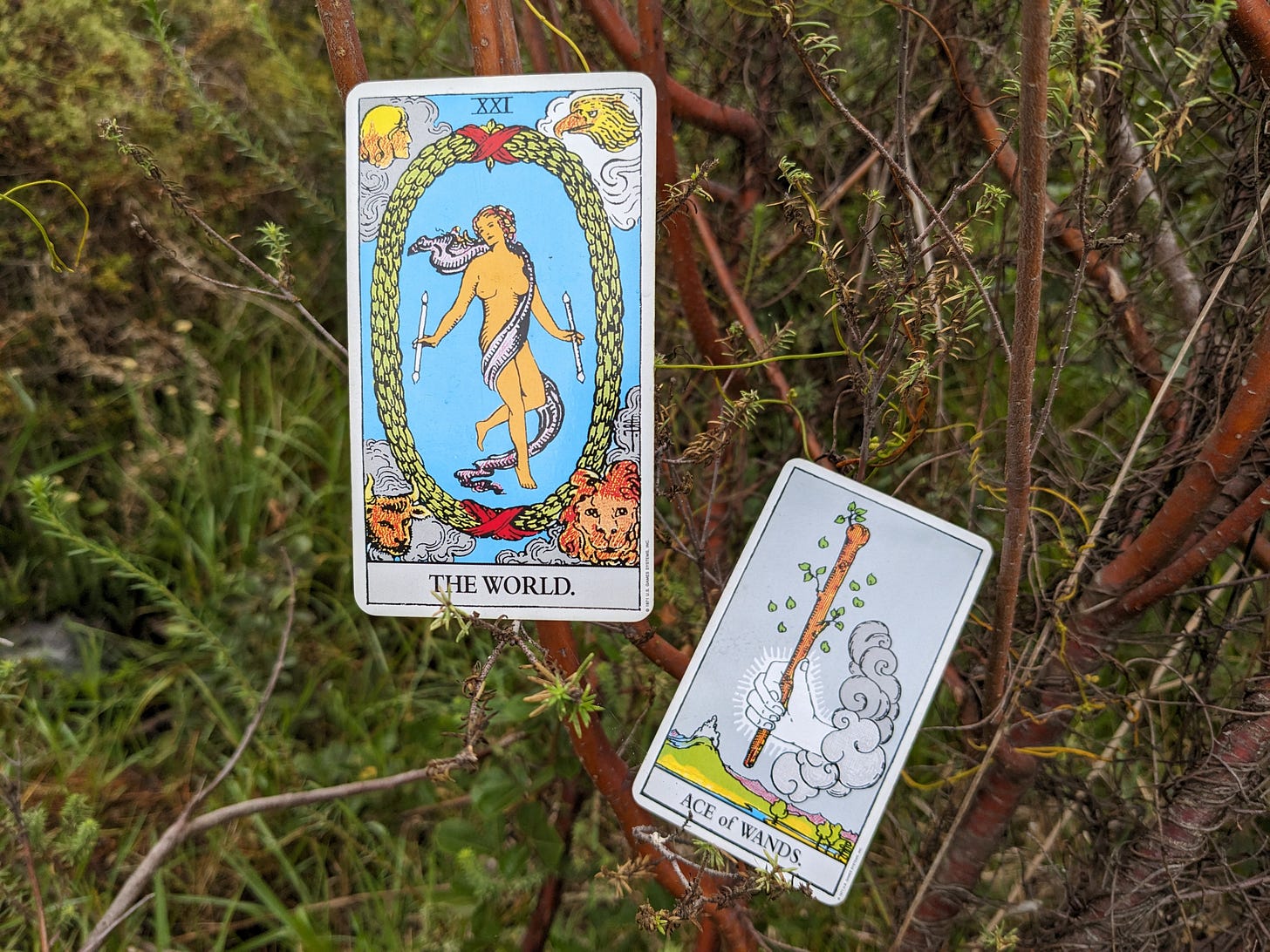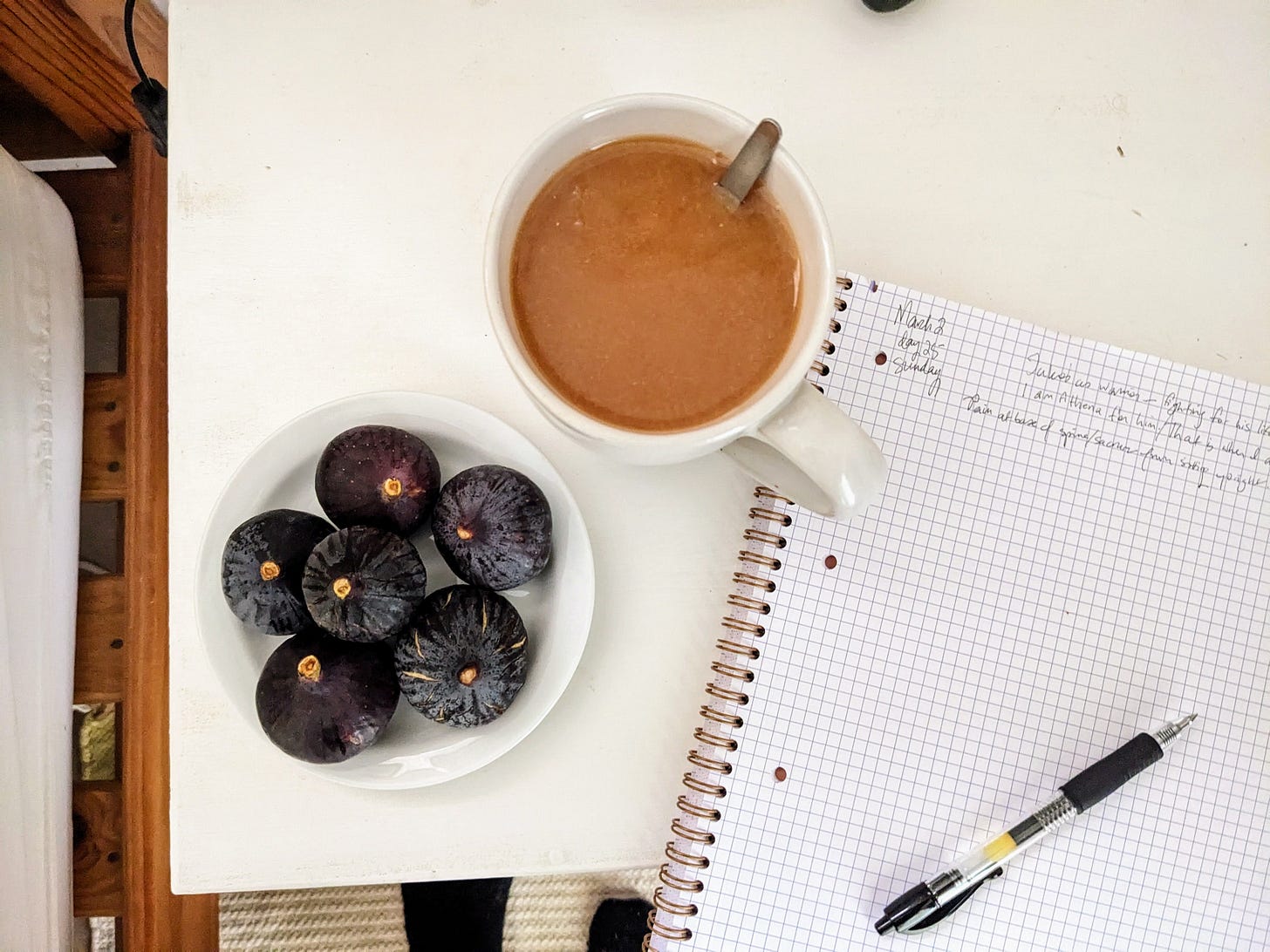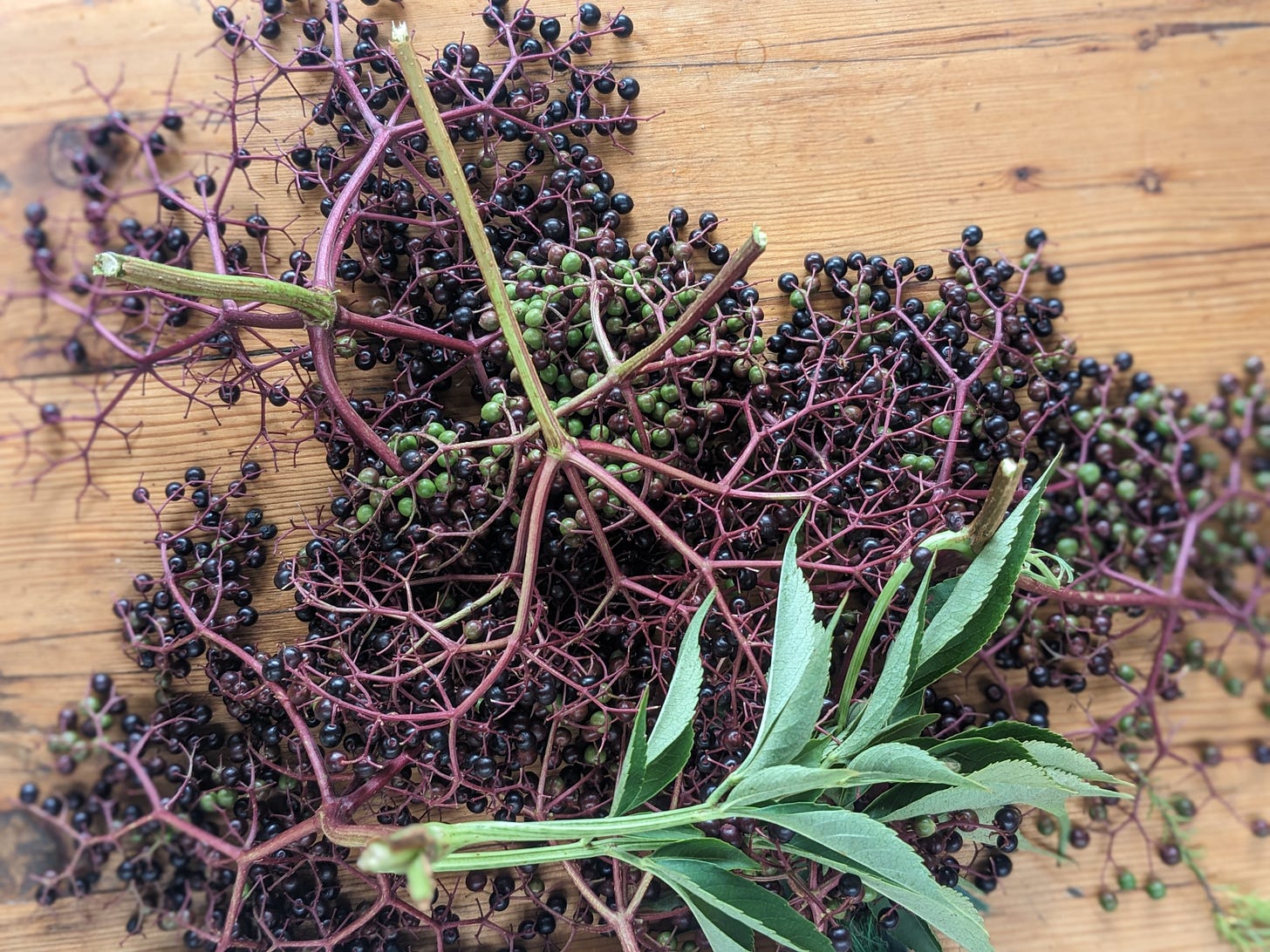Just a quick note that hitting the like/heart button is a good, free, & easy way to support this newsletter. Sharing with friends is even better.
In my Tarotscope for this month (thank you, beloved Elliot), I got good news. The World cropped up, the last card of the Major Arcana, designating a zenith, signaling the finish and mastery of “not just a chapter of your life,” as Elliot Adam says, “but a volume.” A full draft of my monograph is due soon, so this tracks. Thankfully, as if to quell any imminent void-fear, the Ace of Wands came up alongside The World, a card of inspired new beginnings to complement that card of completion.
This reminded me of all the work I’ve been doing lately, in particular the reading and rereading. As you know from previous posts, I read a lot of books at one time, pretty much all the time. If I’m in a place of relative health, then the reading is flowing freely, nourishing my flows of thinking, writing, and movement. Particularly in the luteal phase of my cycle (ie PMS, aka premenstrual strength), I can be gripped by a mania of research, where these ‘flows’ of contemplative activity are more like throes, a thrashing, rushing river.
If I can ‘hold the tension’ and ride the current as it swells, it’s not too stressful, and I don’t choke or slip away. The arrival of blood brings the moment when the mind-raft bobs innocently up out of the still pool at the base of the waterfall. Whatever materials of theory and practice I had been fjording melt away into background hum, and I’m left to my own (less wordy/conceptual) devices.
I am there now, but I want to make a quick note before stepping away from this rush entirely. In case the contents are of interest, here’s a list of books I’ve read lately or am reading now. I’ll stick to those from just this 2025 Aquarius and Pisces season, and only choose ones that have provided useful ideas for tangible application in my life, in the hopes that should you choose to pick one up (or ask an LLM to summarize for you), they’ll help you, too.
All texts available free at Anna’s Archive.
Spring Reading: An Incomplete List
I am one of those people who reads a lot of books at one time, and who goes through phases of single-minded voracity for reading. I have always been a reader, thanks to my mother, who gave me the bug by reciting Longfellow when I was a child and who always has a dozen books checked out or waiting for her at the public library. Colder months especially w…
Cookbooks and Living
My partner and I recently signed our first legit lease, for an awesome apartment in our favorite city, and homemaking fantasies have been dominating my waking thoughts. It is our first real place together. I love cooking, and this will be the first time I have ever had my own kitchen. Cue cookbooks.
The Art of Simple Food, Alice Waters (2007).
A long time ago, a friend and I sweet-talked our way into a seat in the tea room of Chez Panisse and ordered everything we could reasonably afford: a two-person French press, salads composed of herbs and fruits, and a dessert of rose petals coated in sugar. This book is a Bay Area classic, laid-back and elegant. I especially appreciate her suggestions for how to stock a pantry. This is also my go-to source for kitchen equipment and organization, cutting techniques, and standard recipes like mayonnaise, vinaigrette, chicken broth, egg dishes; also simple fancy things like poaching fruit. One of the best meals of my life was a kale salad, dressed in fresh raspberry vinaigrette made with rendered bacon fat, topped with sliced apricots and parsley, that my chef/farmer friend adapted from Alice Waters. (Hi Ryan, I still love you.)
Nourishing Traditions, Sally Fallon (1999).
The kind of hippie stuff I go for since my late-teens experiences in the nudist vegan co-op at Berkeley. A simple cookbook and DIY handbook for those who would return to food preparation techniques of ‘traditional’ and nonindustrialized peoples. Political in that it stated then what we all now know about the toxicity of industrialized food. Great sections on fermentation and sprouting. In the tradition of his own family, my partner makes a lot of his own foods, and I was converted by the money-saving aspect, and the higher quality. I am eager to be a person who always has homemade kvass and kombucha on hand.
The Life-changing Magic of Tidying Up, Marie Kondo (2010).
I dug this one up in anticipation of designing my own space for the first time and wanting to get it perfect the first time. Having lived out of cars and suitcases the past few years, we are ahead in that we don’t have much clutter yet. Our plans include all floor furniture: mats, futons, and meditation cushions. Kondo has key reminders for where and how to put things away so that the kanso minimalism of our dreams stays feasible and pleasing. Bonus: I forgot how unhinged she sounds in this book.
Gardening Month by Month, Martha Stewart (1991).
The imminent apartment has a balcony, of decent size, with one long planter box for herbs and greens and space for hanging rope-strung boards to hold more pots that gets a decent bit of sun. I have never really gardened before, and, like dance, have always secretly desired to do so. Last fall in Germany I participated in an educational bike tour (very German action) where we visited collective gardening projects (very German topic) and learned about solidarity agriculture (aka SoLaWis), similar to CSAs in the US, but of course more socialist and, well, green. This may seem a far cry from Martha’s Hamptons home, etc., but her early books especially still stand out to me as the DIY harbingers for a nation that would benefit enormously from learning to take care of its relationship to the earth, to feed itself well, and to learn to help its neighbors (I mean help its neighbors, not ‘help’ its ‘neighbors’...). This book is mostly a fantasy jaunt through gorgeousness for me, while in fact being a very practical and comprehensive how-to book for those with gardens.
Personal Development
Existential Kink, Carolyn Lovewell (2020).
This book offers a shadow-integration process that frees you from negative patterns (financial, interpersonal, health, creativity, etc). In grand California tradition, EK freely mixes Buddhist precepts with pagan magickal ones to show you how to make more money and have more sex and be happy. I do appreciate that the writing is of much higher quality than most self-help books of the moment. It has lots of interesting exercises designed to unstick your unconscious blocks and get you reveling in the sensational (literally) experience of your life – those you mark ‘painful’ just as much as those you mark ‘pleasurable.’ As much about the practice of presence as anything else, so, a potent reminder that by and large, we get to decide how we feel.
Embracing Your Inner Critic: Turning Self-Criticism into a Creative Asset, Stone + Stone (1993).
The authoritative book on this increasingly popular topic. The inner critic is one of the more significant parts in parts work for me, after getting three degrees specializing in a field literally called Criticism, which has predictably dysregulated my creative flow and general sense of well-being, and …turned me into one of these people who reads these kinds of books… this is a great one, patient and accessible, with exercises leading you (eventually) into compassionate and productive dialogue with this inner voice. Helpful pairing for people working The Artist’s Way or any other therapeutic recovery programs, or who are becoming aware of and processing trauma and/or wounding (so, everyone, and especially people who did MFAs).
Psychedelic Psychotherapy: A User-Friendly Guide to Psychedelic Drug Assisted Psychotherapy, R Coleman (2017).
This is the standard text to which I would refer anyone interested in working with psychedelics explicitly for healing who are not already embedded in a community where traditional practices are interwoven in the social life of the place. Written by someone with years of experience in the psychedelic underground, it is comprehensive, short, and extremely clear: why use drugs, how they work on trauma, guidelines for the sitter, guidelines for the journeyer, descriptions of preparation for the work, navigating peak experiences, approaching shadow work, resourcing, journey aftercare, etc. As Coleman promises: “It’s never too late to have a happy childhood.”
Esoteric Spirituality
The Illustrated Light of Yoga, BKS Iyengar (1966, 1980).
“Yoga is not a religion; it is the science of religion.” A shortened edition of the classic introduction to yoga, with pages describing 57 (instead of 200+) asanas. Iyengar’s is the tradition of yoga my grandmother was doing as a young housewife in 1950s Pittsburgh. For my part, I have been lightly fantasizing about doing a Yoga Teacher Training after finishing my PhD (every ending is a new beginning), and recently met a woman who, among other things, teaches yoga and qigong. I met her at a farmer’s market (wares including homemade magic treats made of figs from her enormous garden). We were standing at the edge of her garden the other day and talking about yoga and she was exuberant and insistent that I go for the training. “When people move,” she says, “they move their minds.” Predictably, when I got online, I didn’t love the price tag on local trainings, so I decided to see how much I could teach myself.
This text is legit. It’s divided into three sections: the first is theoretical (“Yoga is the yoking of all powers of mind, body, and soul to God”), about the stages of yoga (including purification, concentration, meditation, etc), while the second two contain how-to for the basic asanas (postures) and pranayamas (breathwork). There’s an appendix with dozens of asana sequences for self-study, and a large glossary for the Sanskrit terms and concepts. It’s refreshing and grounding to work with a source text like this one instead of trying to get the information piecemeal and compromised over social media. That said, Yoga with Adriene on YouTube is still the best free resource that’s not an old book, so until I find the perfect studio and fork over the cash, I’m going to pair this reading with Ms. ‘Find What Feels Good.’
Total Meditation: Practices in Living the Awakened Life, Deepak Chopra (2020).
“What applies to meditation also applies to transformation: Sit there, stop, be yourself first.” Chopra offers that meditation is our natural mode of consciousness, that it is effortless and spontaneous, and even that it aligns with our own desires. Iyengar might not agree that personal desire has a part to play in meditation, but if we want to read this and, say, Existential Kink in the same breath, framing in terms of accepting the desire of the moment makes sense, at least as a step along ‘the path’. Chopra’s been writing books for so long, and with books like this one and Metahuman, I think he’s honed his blade. The most interesting thing in this book for me is his descriptions of eight forms of ‘meditation mode’ that the mind can practice, and sample methods for getting into each of them: mindfulness; self-inquiry; reflection; contemplation; concentration; prayer; quiet mind; controlled breathing; bliss… if you really were patient with yourself and worked through this book, you wouldn’t need another book on meditation (except maybe Will Johnson’s Posture of Meditation for the physical aspect).
As regards renunciation, the question arises as to what one should renounce. The yogi does not renounce the world, for that would mean renouncing the Creator. The yogi renounces all that takes him away from the Lord. He renounces his own desires, knowing that all inspiration and right action come from the Lord. He renounces those who oppose the work of the Lord, those who spread demonic ideas and who merely talk of moral values but do not practise them.
The yogi does not renounce action. He cuts the bonds that tie himself to his actions by dedicating their fruits either to the Lord or to humanity. He believes that it is his privilege to do his duty and that he has no right to the fruits of his actions.
While others are asleep when duty calls and wake up only to claim their rights, the yogi is fully awake to his duty, but asleep over his rights. Hence it is said that in the night of all beings the disciplined and tranquil man wakes to the light…









